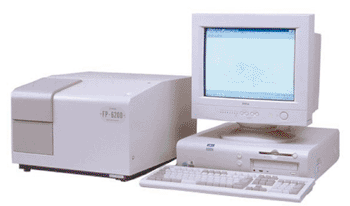Blood Spots Compared with Plasma Sample for Chitotriosidase Assay
By LabMedica International staff writers
Posted on 07 Jan 2014
The chitotriosidase enzyme is markedly elevated in plasma of patients with Gaucher's disease, a relatively common lysosomal storage disorder (LSD). Posted on 07 Jan 2014
Chitotriosidase activity in plasma is also established as a therapeutic monitor for enzyme replacement therapy in Gaucher's patients and is under consideration to monitor therapy in other diseases such as Fabry disease, nephropathic cystinosis, and sarcoidosis.

Image: FP-6200 Series Spectrofluorometer (Photo courtesy of Jasco).
Clinical biochemists at Cairo University (Giza, Egypt) compared blood spot samples with the corresponding plasma levels in 199 children of whom 56 were with confirmed diagnoses of 10 different lysosomal storage disorders, 73 normal controls, and 70 pathological controls. Several performance criteria such as limit of detection, linearity, within-run and day-to-day precision and sample stability were also evaluated.
Chitotriosidase activity in plasma and blood spot samples was measured using the substrate 4-methylumbelliferyl-β-D-N,N′,N″-triacetylchitotrioside (4-MU-C3) (Sigma-Aldrich; St. Louis, MO, USA). Fluorescence activity was measured with a FP 6200 spectrofluorometer, (Jasco; Tokyo, Japan) with excitation at 365 nm, and emission at 448 nm. Enzyme activities were calculated based on a calibration curve of 4-methylumbelliferone (4-MU) for each assay.
The calculated values for limit of detection were very comparable between the two methods: 2.7 and 2.0 nmol/mL/h for the plasma and blood spot assays, respectively. Similarly, the determined limits of quantification were 3.6 nmol/mL/h for plasma and 3.5 nmol/mL/h for blood spots. Although the precision using blood spots was inferior to plasma, it was quite acceptable for a blood spot method as the calculated limit of detection for blood spots was acceptable, looking at the wide range of the analytical spectrum. The plasma cutoff limit of 1,000 nmol/mL/h offered 100% sensitivity and 99% specificity for Gaucher's patients, while a blood spot cutoff limit of 400 nmol/mL/h offered 100% sensitivity and 97% specificity.
The authors concluded that blood spot sampling offers many advantages over traditional venous sampling. The level of agreement between blood spot and plasma chitotriosidase using the 4-MU-C3 substrate was found to be acceptable. Blood spot chitotriosidase is a clinically valid test. The study was published in the January 2014 issue of the journal Clinical Biochemistry.
Related Links:
Cairo University
Sigma-Aldrich
Jasco














